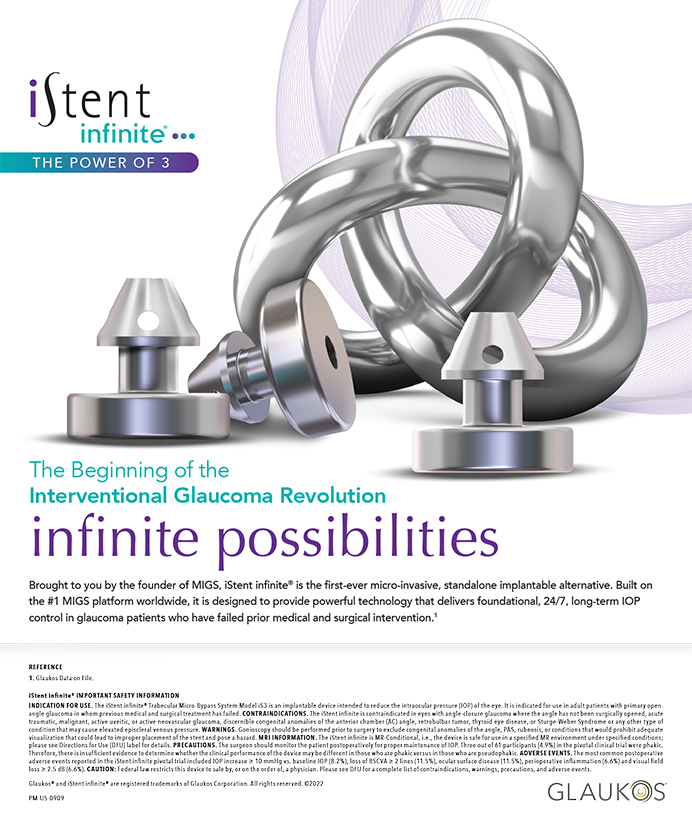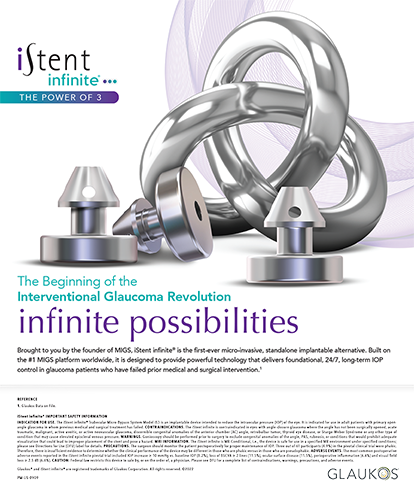The most significant advances in LASIK to date include the accuracy with which wavefront aberrometry measures astigmatism and how precisely a wavefront-guided ablation can correct it. Surprisingly, many patients today are still under the impression that having astigmatism precludes them from undergoing LASIK. They are happy to learn that I treated my first astigmatic patient 15 years ago, following the FDA's initial approval of the Visx laser for this procedure.
Patients understandably tend to be most interested in learning about the changes in the excimer laser portion of LASIK as well as how the flap is made. The addition of eye-tracking technology and iris recognition for improved treatment registration generally resonates with patients, but they sometimes fail to realize the significance of improvements in preoperative screening. During a given day, while performing preoperative consultations, I find myself emphasizing the advances in the preoperative portion of LASIK and the improvement in the imaging systems that are in use today. Surgeons are armed with far better and so much more preoperative data than in the past that patients are sometimes shocked.
MOST EYES ARE NOT COMPLETELY SPHERICAL
Given the advanced sensitivity of wavefront analysis, it is rare to measure no astigmatism in an eye. A lack of complete sphericity is not only common; it is expected. Treating even small amounts of astigmatism, particularly in a patient who wears soft contact lenses with no cylindrical correction, nearly always results in his or her saying, “I see better now than I ever did with my contacts.” These are the true gems of LASIK, and there is straightforward math regarding astigmatic correction to support this theory, as outlined in the case example later in this article.
I most fully appreciate the impact of wavefront analysis, however, when treating patients who require the correction of large amounts of cylinder. Often, there is a discrepancy between the spectacle or contact lens prescription, the amount of topographic cylinder, the manifest cylinder finding, and the WaveScan WaveFront System's (Abbott Medical Optics Inc.) cylinder measurement. Reconciling these four data points preoperatively can be challenging.
In my experience, the most exacting and reliable measurement, and the foundation upon which I base a LASIK treatment, is the WaveScan. It is exceptionally accurate preoperatively, and the postoperative results—even on day 1—reflect this precision, as the case described herein demonstrates. Surgeons owe a debt of gratitude to David Hardten, MD, for his inspired wavefront-assisted manifest refraction or WAMR approach, which is exactly how I approach my LASIK patients. That is, surgeons perform aberrometry first and then plug the wavefront-derived refraction into the phoropter as the starting point for the manifest refraction. Additionally, “trust the WaveScan, particularly with respect to cylinder degree and axis,” is a foundation of my LASIK practice.
CASE EXAMPLE
A 31-year-old white woman presented to me for LASIK. Her slit-lamp examination, pachymetry, and ocular and general health were completely normal. Only information on her left eye will be presented in this article.
The manifest refraction from her referring doctor was -5.75 -2.25 × 175 = 20/20. The Topographic Modeling System TMS 4 (Tomey Corporation) showed simulated keratomery values of K1 45.17 @ 176 and K2 47.53 @ 086 for a corneal keratometric value of 2.36 D (Figure 1). Her preoperative WaveScan measurement was -5.47 -2.78 × 176 at a 4-mm Rx calculation (Figure 2), as is typical. On the day of her LASIK surgery, her WAMR was -5.50 -2.75 × 180 = 20/20.
When there are three different refractions, what adjustments should be made? Surgeons nearly always accept the astigmatic correction in a scenario like this and treat the full WaveScan-measured degree of cylinder, an approach that is invariably very accurate. In a 31-year-old, such as in this case, I target a bit of hyperopia and make a surgeon's adjustment to reflect this. For this patient, who manifested -5.25 D sphere, I added -0.35 D to the spherical correction prior to treatment.
One day after uncomplicated LASIK using the iFS and the VISX S4 excimer laser (both manufactured by Abbott Medical Optics Inc.), the patient's UCVA was 20/15. Although I almost never take a wavefront image on the first postoperative day, I did so at this patient's request, and her wavefront map is shown in Figure 3. The Rx measured +0.72 -0.26 × 001 less than 24 hours after her surgery.
DISCUSSION
Decisions regarding a patient's suitability for LASIK can be complex, particularly when there are differences in the numbers generated by the various techniques that are currently used to determine the magnitude of astigmatism (manifest refraction, topography, wavefront aberrometry). These discrepancies can even affect whether or not a surgeon thinks a patient actually has a stable prescription. With current software, physicians' adjustments are limited to the spherical component of the refraction (+0.75 to -0.75). The only option to adjust the cylindrical component is to make a change under the default nomogram adjustment (“boost”), which can be found under the Treat Settings tab. For patients with myopia, this option allows for a percentage change (-10% to +10%), which affects both sphere and cylinder.
I do not routinely use this setting. Instead, I prefer to accept the WaveScan-measured amount of cylinder and to adjust only the sphere on a case-by-case basis. This approach has proven successful for me. When confronted with a difference between manifest cylinder and wavefront cylinder, I rarely default to a conventional treatment. Rather, I trust the WaveScan, and my outcomes have firmly supported this technique.
Stephen Coleman, MD, is the director of Coleman Vision in Albuquerque, New Mexico. He is a consultant for Abbott Medical Optics Inc. Dr. Coleman may be reached at (505) 821-8880; stephen@colemanvision.com.


